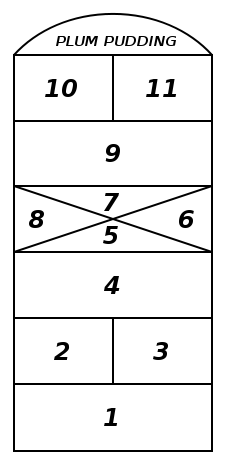Stapu
Stapu is an outdoor game mostly played in India. Its also known as Hopscotch Stapu is a game that everybody can play with any number of players. Stapu is made with boxes and numbers written inside the boxes from number 1 to number 10. It’s not compulsory to write numbers till 10 but you will need valid boxes and the numbers can be continued as long as you want. The first end is called Start and the last end is called Sea. Remember use one of your leg to jump on boxes.
Hopscotch
In India, hopscotch is also called Kith-Kith, Stapu, in the Hindi-speaking areas, or Ek-hat – Du-hat in Bengal, Chirpi in Maharashtra, Kunte bille in Karnataka, Paandi in Tamil Nadu, and Tokkudu Billa in Andhra Pradesh and Telangana. These games have similar principles in that players must hop on one foot and must throw the marker in the right square. The game is mostly common among girls in India, though some boys play too.
How to play Stapu?
Take a nice stone that is flat from all sides and can be in any shape. First throw the stone on first number. Leaving that particular box jump on all the rest boxes. On your last box turn back and reverse.
When you reach the box on which your stone is, pick up the stone and jump on start. Repeat this on all the boxes of numbers.
If the stone goes in wrong order or set on a line the player is said to be out and is asked to wait for his/her chance to come again.
When you come on the sea. Throw the stone with all your pressure. If it goes too long ask any member to give you glasses.
Glasses are number of footsteps taken by the player to make your stone near.
Ask the player for glasses he/she needs. And take that particular number of footsteps. Say the player to look up and make crosses with that stone on that place. Say the player to honestly close him/her eyes and jump on the cross.
If the player jumps on any other place he/she is again said to be out. If passed again jump on the boxes just as you did in the beginning but reverse the counting by starting from back.
Again repeat the cross process when on the start.
When you are over with this you can turn behind and throw the stone anywhere you wish. If the stone drops on any box the box is said to be your house and no one can step on it.
If any person is still playing you will have to divide the box into two halves one as your house and the other as the left players box.
When you have made your house on all over the Stapu you are said to be the Winner!
This is how you can play this Indian outdoor game Stapu.
The court
To play hopscotch, a court is first laid out on the ground. Depending on the available surface, the court is either scratched out in dirt, or drawn with chalk on pavement. Courts may be permanently marked where playgrounds are commonly paved, as in elementary schools. Designs vary, but the court is usually composed of a series of linear squares interspersed with blocks of two lateral squares. Traditionally the court ends with a “safe” or “home” base in which the player may turn before completing the reverse trip. The home base may be a square, a rectangle, or a semicircle. The squares are then numbered in the sequence in which they are to be hopped.



Playing the game
The first player tosses the marker (typically a stone, coin or bean bag) into the first square. The marker must land completely within the designated square and without touching a line or bouncing out. The player then hops through the course, skipping the square with the marker in it. Single squares must be hopped on one foot. For the first single square, either foot may be used. Side-by-side squares are straddled, with the left foot landing in the left square, and the right foot landing in the right square. Optional squares marked “Safe”, “Home”, or “Rest” are neutral squares, and may be hopped through in any manner without penalty. After hopping into “Safe”, “Home”, or “Rest”, the player must then turn around and return through the course (square 9, then squares 8 and 7, next square 6, and so forth) on one or two legs depending on the square until s/he reaches the square with her marker. S/he then must retrieve her marker and continue the course as stated without touching a line or stepping into a square with another player’s marker.
Upon successfully completing the sequence, the player continues the turn by tossing the marker into square number two, and repeating the pattern.
If, while hopping through the court in either direction, the player steps on a line, misses a square, or loses balance, the turn ends. Players begin their turns where they last left off. The first player to complete one course for every numbered square on the court wins the game.
Although the marker is most often picked up during the game, historically, in the boy’s game, the marker was kicked sequentially back through the course on the return trip and then kicked out.